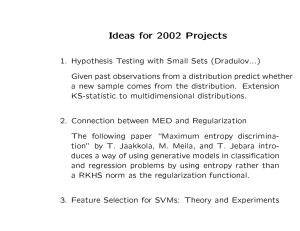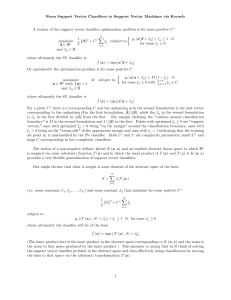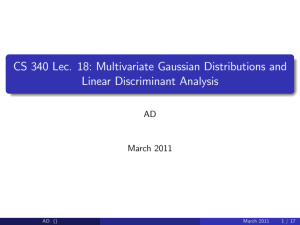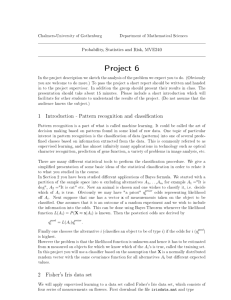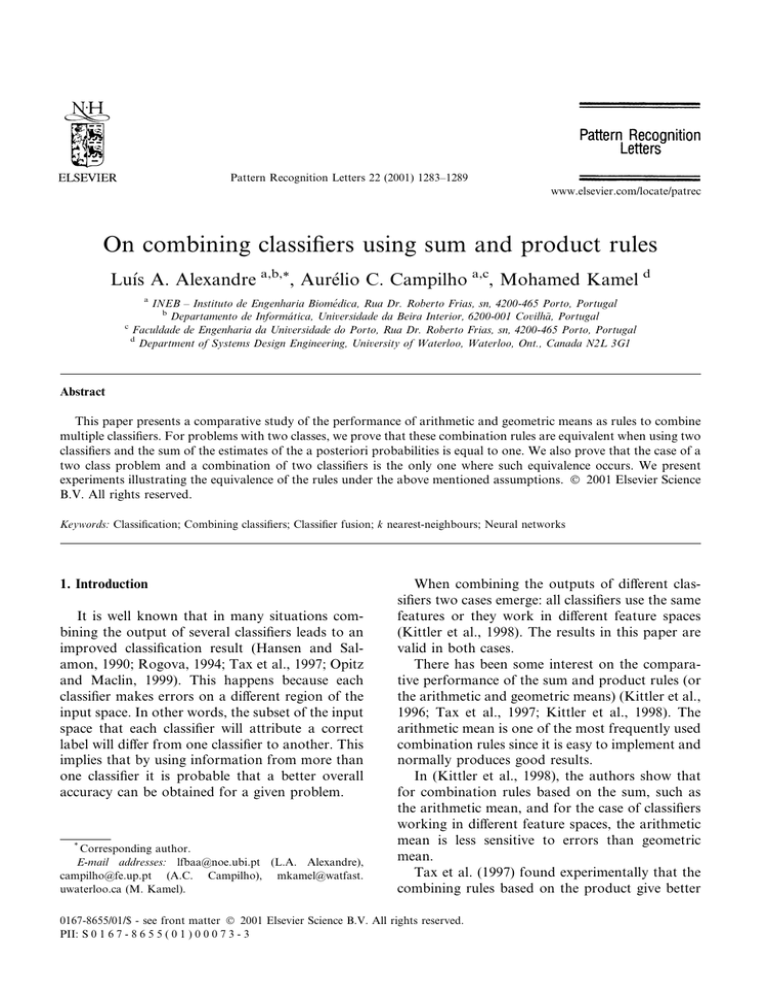
Pattern Recognition Letters 22 (2001) 1283±1289
www.elsevier.com/locate/patrec
On combining classi®ers using sum and product rules
Luõs A. Alexandre a,b,*, Aurelio C. Campilho a,c, Mohamed Kamel d
a
INEB ± Instituto de Engenharia Biom
edica, Rua Dr. Roberto Frias, sn, 4200-465 Porto, Portugal
b
Departamento de Inform
atica, Universidade da Beira Interior, 6200-001 Covilh~
a, Portugal
c
Faculdade de Engenharia da Universidade do Porto, Rua Dr. Roberto Frias, sn, 4200-465 Porto, Portugal
d
Department of Systems Design Engineering, University of Waterloo, Waterloo, Ont., Canada N2L 3G1
Abstract
This paper presents a comparative study of the performance of arithmetic and geometric means as rules to combine
multiple classi®ers. For problems with two classes, we prove that these combination rules are equivalent when using two
classi®ers and the sum of the estimates of the a posteriori probabilities is equal to one. We also prove that the case of a
two class problem and a combination of two classi®ers is the only one where such equivalence occurs. We present
experiments illustrating the equivalence of the rules under the above mentioned assumptions. Ó 2001 Elsevier Science
B.V. All rights reserved.
Keywords: Classi®cation; Combining classi®ers; Classi®er fusion; k nearest-neighbours; Neural networks
1. Introduction
It is well known that in many situations combining the output of several classi®ers leads to an
improved classi®cation result (Hansen and Salamon, 1990; Rogova, 1994; Tax et al., 1997; Opitz
and Maclin, 1999). This happens because each
classi®er makes errors on a dierent region of the
input space. In other words, the subset of the input
space that each classi®er will attribute a correct
label will dier from one classi®er to another. This
implies that by using information from more than
one classi®er it is probable that a better overall
accuracy can be obtained for a given problem.
*
Corresponding author.
E-mail addresses: lfbaa@noe.ubi.pt (L.A. Alexandre),
campilho@fe.up.pt (A.C. Campilho), mkamel@watfast.
uwaterloo.ca (M. Kamel).
When combining the outputs of dierent classi®ers two cases emerge: all classi®ers use the same
features or they work in dierent feature spaces
(Kittler et al., 1998). The results in this paper are
valid in both cases.
There has been some interest on the comparative performance of the sum and product rules (or
the arithmetic and geometric means) (Kittler et al.,
1996; Tax et al., 1997; Kittler et al., 1998). The
arithmetic mean is one of the most frequently used
combination rules since it is easy to implement and
normally produces good results.
In (Kittler et al., 1998), the authors show that
for combination rules based on the sum, such as
the arithmetic mean, and for the case of classi®ers
working in dierent feature spaces, the arithmetic
mean is less sensitive to errors than geometric
mean.
Tax et al. (1997) found experimentally that the
combining rules based on the product give better
0167-8655/01/$ - see front matter Ó 2001 Elsevier Science B.V. All rights reserved.
PII: S 0 1 6 7 - 8 6 5 5 ( 0 1 ) 0 0 0 7 3 - 3
1284
L.A. Alexandre et al. / Pattern Recognition Letters 22 (2001) 1283±1289
results when all classi®ers produce small errors.
If at least one of the classi®ers makes large errors then the arithmetic mean rule gives better
results.
We show that when working in a classi®cation
problem with two classes, and using two classi®ers
that give estimates of the a posteriori probabilities
that sum to one, such as k nearest-neighbour (kNN) classi®ers, the combination rules arithmetic
mean (or the sum) and the geometric mean (or the
product) are equivalent. That is, they have exactly
the same error rates. We also show that this is the
only case when these rules are equivalent when
using this type of classi®ers.
In Section 2 we de®ne the problem and introduce the notation. In Section 3 we study the performance of the two combination rules under the
above mentioned assumptions. In Section 4 we
investigate the consequences of violating these
assumptions. In Section 5 several experiments are
presented that illustrate the dierent aspects of the
problem under consideration. Section 6 presents a
discussion of the results and in the last section
conclusions are posted.
2. Basic Concepts
This section introduces the formalism, presents
the problem de®nition and describes the combination process.
2.1. Problem de®nition
A pattern is, in general, a p-dimensional, real
valued, vector x. It is associated with a class label
which can be represented by y 2 fc1 ; . . . ; cL g. We
call a set of patterns with their classes a test set:
TS f
xi ; yi ; i 1; . . . ; T g.
The goal of classi®cation is, given a TS, to
correctly attribute a class label to a pattern not in
the TS. This action is made by a classi®er.
Consider that the problem has L classes. Consider also a classi®er that can approximate the a
posteriori probability functions p
cj jx, which
gives the probability of the pattern x belonging to
a given class cj , given that x was observed. It is
then natural to classify the pattern by choosing the
class with the largest a posteriori probability:
x 2 ck
if p
ck jx max p
cj jx
j
1
2.2. Single classi®er
Consider a single classi®er whose outputs are
expected to approximate a posteriori probabilities
p
ci jx, where ci stands for class i and x is the input
to the classi®er.
The approximation to the a posteriori probability p
ci jx provided by a single classi®er j, is
fij
x p
ci jx ji
x;
where ji
x represents the error that the classi®er j
introduces, when approximating the a posteriori
probability p
ci jx.
2.3. Combining dierent classi®ers
As mentioned before, strong evidence exists
that better classi®cation can be obtained if instead
of using the predictions of a single classi®er, the
information from several classi®ers is used. This
information is then combined to produce a ®nal
decision.
Consider N classi®ers that produce approximations to the a posteriori probabilities. For a
given input pattern x, each classi®er j will produce
L approximations to the a posteriori probabilities,
fij
x; i 1; . . . ; L.
The combining of information from the dierent classi®ers is done by building new predictions
for the a posteriori probabilities from the individual classi®ers' predictions. The combined prediction for class ci is then
ficomb
ui G
ui ;
2
where ui
fi1
x; . . . ; fiN
x, `comb' represents
a given combination rule and G
is some function.
This process is illustrated in Fig. 1, where the
®nal class label j is such that
fjcomb > ficomb
8i 6 j; i; j 2 f1; . . . ; Lg
and the Ki are the classi®ers.
L.A. Alexandre et al. / Pattern Recognition Letters 22 (2001) 1283±1289
1285
Case 1:
u1
1u1
2 > u2
1u2
2 ^ u1
1 u1
2
< u2
1 u2
2
6
Given (5) we can rewrite the ®rst part of expression
(6) as
1
u2
1
1
u2
2 > u2
1u2
2
or
u2
1 u2
2 < 1:
Fig. 1. The combination process.
The second part of expression (6) can also be
rewritten using (5)
2.4. Averaging combination rules
We are interested in comparing the performance of combining using the following possibilities for the function G
ui : an arithmetic mean,
giving the following form for ficomb
fiam
ui
N
1 X
ui
j
N j1
and a geometric mean
!1=N
N
Y
gm
fi
ui
ui
j
;
3
4
1
where ui
j denotes the jth component of vector ui .
3. Performance of the combination rules
We start by proving that under some conditions
the previous combination rules are equivalent and
then show that those are the only conditions for
the equivalence.
3.1. Equivalence of sum and product with L N 2
Since L 2, there are two vectors of a posteriori probabilities: u1 and u2 . And given that N 2,
these vectors have two coordinates: ui
j;
i 1; 2; j 1; 2. We are considering classi®ers
whose estimates of the a posteriori probabilities
sum to one, that is
i 1; 2:
5
There are two cases when the sum and the
product disagree in their predicted class.
u2
1 1
u2
2 < u2
1 u2
2
or
u2
1 u2
2 > 1:
8
It is impossible that a point u2 satis®es both (7)
and (8) simultaneously.
The second case when the sum and the product
disagree in their predicted class is
Case 2:
u1
1u1
2 < u2
1u2
2 ^ u1
1 u1
2
> u2
1 u2
2
j1
u1
i u2
i 1;
7
9
As in Case 1, a point now would have to satisfy
conditions (7) and (8), which is impossible. This
proves that it is not possible to ®nd two points that
obey (5) and make the sum and product disagree,
for a two class problem.
This makes the arithmetic and the geometric
mean equivalent when combining two classi®ers
that obey (5) in any two class problem.
3.2. General case
In this section we prove that this equivalence of
the combination rules does not generalise for other
values of
L; N other than
2; 2.
In general, Eq. (5) becomes
L
X
ui
j 1; j 1; . . . ; N :
10
i1
We start by noting that for the case
L 2; N 3 the following two points make the
product and the sum rule disagree
1286
L.A. Alexandre et al. / Pattern Recognition Letters 22 (2001) 1283±1289
fu1
0; 0:8; 0:8; u2
1; 0:2; 0:2g:
11
(The arithmetic mean of u1 is greater than the
arithmetic mean for u2 making class 1 the chosen
for the arithmetic mean combining rule. The geometric mean of u1 is smaller than for u2 making
class 2 the chosen one for the geometric mean.)
For the case
L 3; N 2 the following three
points make the combination rules disagree.
fu1
0:1; 0:65; u2
0:4; 0:3; u3
0:5; 0:05g:
12
We now describe a way to create from these
points other points that make those rules disagree
for values of
L; N other than
2; 2.
To create a new set of points that make the
combination rules disagree for
L; N from a set of
points that make the combination rules disagree
for
L 1; N it is enough to consider a new point
uL with all coordinates equal to zero. Example:
from the points in (11), create a new set of points
that make the product and the sum rule disagree
for
L 3; N 3. The new set of points is then
fu1
0; 0:8; 0:8; u2
1; 0:2; 0:2; u3
0; 0; 0g:
13
This process guarantees that the new points obey
to (10) and they do not change the initial decisions
of the classi®ers since what happens is that the new
point will have the smallest sum and the smallest
product (both zero) and since the decision is made
using the maximum it will not interfere with the
initial con¯icting decision.
To create a new set of points that make the
combination rules disagree for
L; N from a set of
points that make the combination rules disagree
for
L; N 1 it is enough to add to each point a
new coordinate with value equal to 1=L.
Example: from the points in (11), create a new
set of points that make the product and the sum
rule disagree for
L 2; N 4. The new set of
points is then
fu1
0; 0:8; 0:8; 0:5; u2
1; 0:2; 0:2; 0:5g:
14
This process guarantees that the new points
obey to (10) and they do not change the initial
decisions of the classi®ers since what happens is
that both points will have their sum increased with
the same amount (1=L) and their product multi-
plied by the same amount (also 1=L), thus not
changing the initial con¯icting decision.
By using these two procedures and the sets of
points in (11) and (12), one can ®nd points that
make the combination rules disagree for all values
of
L; N other than
2; 2. (Note that the cases
with N 1 are not combinations of classi®ers and
the cases with L 1 are not classi®cation problems
since all points belong to one single class.)
This way we have shown that the only case
when the arithmetic and the geometric means give
the same result, when used for combining the
outputs of classi®ers that give estimates for the a
posteriori probabilities that sum to one, is when
L N 2.
4. Estimates of the a posteriori probabilities
Depending on the type of classi®er used to
produce the estimation we face two scenarios: either the outputs of the classi®er sum to one thus
obeying Eq. (10) (scenario A) or the outputs do
not sum to one (scenario B).
4.1. Scenario A
Examples of cases that fall into scenario A are
those produced by a k-NN classi®er. It is possible
to produce estimates of the a posteriori probabilities by dividing the number of the k-NNs belonging to a given class, by k, as in
fi
x
nci
x
k
15
with nci being the number of the k-NNs of x belonging to class ci (Bishop, 1995). This way,
L
X
i1
fi
x
L
X
nci
x
1
k
i1
which makes k-NN classi®ers' predictions of the a
posteriori probabilities fall into scenario A.
4.2. Scenario B
Cases that fall into scenario B are those produced, for instance, by a neural network. In this
L.A. Alexandre et al. / Pattern Recognition Letters 22 (2001) 1283±1289
case there are no guarantees that the outputs of
each NN will sum to one.
Another interesting characteristic of these classi®ers is the fact that the error may push the estimate of the a posteriori probabilities out of the
0; 1 interval. This can have a major eect especially on the geometric mean, since the product of
an odd number of negative estimates produces a
negative estimate which will not be chosen even
against the worst positive estimation. This may
have a severe impact on the accuracy of the geometric mean combination estimates.
We will conduct experiments illustrating these
two scenarios and complete the discussion afterwards.
5. Experiments
In this section we present several experiments
that con®rm the previous results.
5.1. Data sets
We used three data sets from the UCI repository (Blake et al., 1998). Details are presented in
Table 1. The ®rst column lists the reference we use
for a given data set, the second lists their names,
the third the number of patterns, the fourth the
number of features and the last the number of
classes in the problem.
5.2. Scenario A
In these experiments, k-NN classi®ers using euclidean distance are used to produce estimates of
the a posteriori probabilities using Eq. (15). These
estimates are combined using arithmetic and geoTable 1
Data sets
Reference
Name
#
Points
#
Features
#
Classes
DS1
DS2
Diabetes
Ionosphere
Sonar
768
351
8
34
2
2
208
60
2
DS3
1287
Table 2
Classi®cation errors (in percentage)
Classi®ers
DS1
DS2
DS3
1NN
3NN
5NN
7NN
AM2
GM2
AM3
GM3
AM4
GM4
32.03
30.60
28.52
27.21
32.03
32.03
32.03
32.03
30.08
32.03
13.43
15.14
15.43
16.29
13.43
13.43
13.43
13.43
14.00
13.43
17.31
18.27
17.31
23.08
17.31
17.31
17.31
17.31
19.23
17.31
metric means. Experiments were made with two,
three and four k-NN classi®ers. Table 2 presents
the errors for each data set, and for the combinations: `AMi' means `arithmetic mean combination
of the ®rst i classi®ers' and `GMi' means `geometric
mean combination of the ®rst i classi®ers'.
5.3. Scenario B
We made experiments combining two, three
and four feed-forward neural networks only differing in their topology and in the weight initialisation (which is done randomly). The classi®ers
should approximate a posteriori probabilities, and
these neural networks do so (Richard and Lippmann, 1991). The classi®ers are multi-layer perceptrons (MLPs), trained for 300 epochs using
resilient backpropagation (Demuth and Beale,
1998). Their topology is presented in Table 3,
where the ®rst number indicates the number of
neurons on the input layer, the second represents
the number of neurons in the hidden layer and the
last represents the number of neurons on the
output layer. Tables 4±6 present the average errors
for each data set along with the respective S.D.
Table 3
Topology of the MLPs
Classi®ers
DS1
DS2
DS3
MLP1
MLP2
MLP3
MLP4
[4 6 2]
[6 6 2]
[8 6 2]
[8 8 2]
[10 5 2]
[15 10 2]
[20 10 2]
[25 10 2]
[5 40 2]
[5 50 2]
[5 60 2]
[10 40 2]
1288
L.A. Alexandre et al. / Pattern Recognition Letters 22 (2001) 1283±1289
Table 4
Average classi®cation errors and S.D. (in percentage) for N 2
Classi®ers
DS1
MLP1
MLP2
AM
GM
31.43
27.80
27.98
27.86
DS2
(4.63)
(4.10)
(3.54)
(3.55)
11.43
11.46
10.86
10.80
DS3
(3.10)
(3.02)
(2.77)
(2.73)
33.22
30.43
29.86
30.53
(5.06)
(3.99)
(3.98)
(4.66)
Table 5
Average classi®cation errors and S.D. (in percentage) for N 3
Classi®ers
DS1
MLP1
MLP2
MLP3
AM
GM
32.51
29.35
28.98
28.10
29.41
DS2
(4.42)
(4.21)
(5.09)
(4.38)
(4.30)
12.40
11.37
11.77
9.94
10.60
DS3
(3.31)
(2.29)
(3.55)
(2.31)
(2.23)
32.98
31.97
32.84
28.75
30.19
(5.86)
(4.57)
(5.44)
(4.78)
(4.93)
Table 6
Average classi®cation errors and S.D. (in percentage) for N 4
Classi®ers
DS1
MLP1
MLP2
MLP3
MLP4
AM
GM
30.18
30.18
28.71
29.40
27.04
28.46
DS2
(5.99)
(4.51)
(3.51)
(4.25)
(3.57)
(4.42)
10.86
11.09
12.06
11.60
9.74
10.34
DS3
(2.78)
(2.50)
(3.72)
(2.33)
(2.60)
(2.23)
34.62
33.08
34.66
34.38
30.63
31.01
(4.48)
(5.92)
(5.56)
(3.09)
(3.31)
(4.81)
The columns show the average error in percentage for the isolated classi®ers and for the
combinations, for each data set. The experiments
were repeated 20 times.
There was not a special care in tuning the individual classi®ers, since the important issue is
comparative performance.
6. Discussion
As expected, in scenario A, the combination of
two classi®ers provide equal results for all data sets,
since they are all two class problems. Notice that in
the case N 3, the combination rules also perform
equally well. But as seen in Section 3.2 this is not
always true. In the combination of four classi®ers
the geometric mean gives better results than the
arithmetic mean for data sets DS2 and DS3.
In scenario B, we see that the combination rules
do not have the same performance, not even for
the case of N 2. This is due to the fact that these
classi®ers do not obey expression (10) as mentioned before.
The arithmetic mean outperforms the geometric mean. The performance gain relative to
the geometric mean is in agreement with results
from Kittler et al. (1998), where it was noted that
the product rule is more sensitive to error than
the sum rule. Note that an eventual negative
output for an estimate of the a posteriori probabilities can be easily compensated in the arithmetic mean by the other positive values, since we
are talking about a sum. In the geometric mean,
an odd number of negative estimates makes the
result negative. The bad performance of the
geometric mean is connected with the fact that a
possible negative value for the a posteriori
probabilities estimates by only one classi®er can
make the result for a given class smaller (negative) than all the other possible not so good
classes but that had no negative output for any
of their a posteriori probabilities estimates.
Another justi®cation for the bad performance of
the geometric mean is that a given classi®er
can make the combination result zero or very
small by giving a zero or very small estimate for
the a posteriori probabilities even if all other
classi®ers give high values for the a posteriori
probabilities.
7. Conclusions
In this paper we study the relative performance
of two types of averaging combination rules:
arithmetic and geometric means. We show that,
for a problem with two classes, and when using
two classi®ers that give a posteriori probabilities
values that sum to one, such as k-NN classi®ers,
these rules have exactly the same performance.
That is, in these cases more than two classi®ers
should be combined in order to have dierent
performances from these combination rules. We
also show that this is the only case when this
equivalence holds. When more than two classi®ers
are combined the geometric mean showed better
L.A. Alexandre et al. / Pattern Recognition Letters 22 (2001) 1283±1289
performance than the arithmetic mean in our
experiments.
We also study the behaviour of these rules when
using classi®ers that do not give estimates of the a
posteriori probabilities that sum to one, such as
MLPs. We conclude experimentally, that in this
case the arithmetic mean outperforms the geometric mean.
Note that the studied combination rules all give
the same importance to all the classi®ers. This leaves
open the combinations using weighted average. See
on this subject the following references: Hashem
(1997), Alexandre et al. (2000) and Ueda (2000).
Acknowledgements
We acknowledge the support of project number
POSI/35590/SRI/2000 approved by the portuguese
FCT and POSI partially ®nanced by FEDER.
References
Alexandre, L., Campilho, A., Kamel, M., 2000. Combining
independent and unbiased classi®ers using weighted aver-
1289
age. In: Proc. 15th Internat. Conf. on Pattern Recognition,
Vol. 2. IEEE Press, Barcelona, Spain.
Bishop, C., 1995. Neural Networks for Pattern Recognition.
Oxford University Press, Oxford.
Blake, C., Keogh, E., Merz, C., 1998. UCI repository of
machine learning databases. http://www.ics.uci.edu/mlearn/
MLRepository.html.
Demuth, H., Beale, M., 1998. Neural Network Toolbox User's
Guide. The MathWorks, Inc.
Hansen, L., Salamon, P., 1990. Neural network ensembles.
IEEE Trans. PAMI 12 (10), 993±1001.
Hashem, S., 1997. Optimal linear combinations of neural
networks. Neural Networks 10 (4), 599±614.
Kittler, J., Hatef, M., Duin, R., 1996. Combining classi®ers. In:
Proc. Internat. Conf. on Pattern Recognition'96.
Kittler, J., Hatef, M., Duin, R., Matas, J., 1998. On combining
classi®ers. IEEE Trans. PAMI 20 (3), 226±239.
Opitz, D., Maclin, R., 1999. Popular ensemble methods: An
empirical study. J. Artif. Intell. Res. (11), 169±198.
Richard, M., Lippmann, R., 1991. Neural network classi®ers
estimate Bayesian a posteriori probabilities. Neural Comput. (3), 461±483.
Rogova, G., 1994. Combining the results of several neural
network classi®ers. Neural Networks 7 (5), 777±781.
Tax, D., Duin, R., Breukelen, M., 1997. Comparison between
product and mean classi®er combination rules. In: Workshop on Statistical Techniques in Pattern Recognition.
Prague, Czech Republic.
Ueda, N., 2000. Optimal linear combination of neural networks
for improving classi®cation performance. IEEE Trans.
PAMI 22 (2), 207±215.

